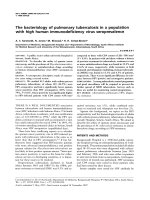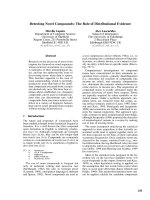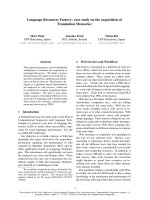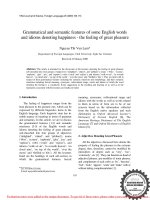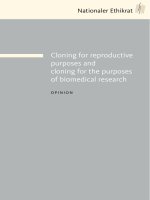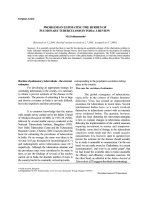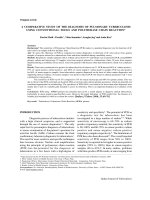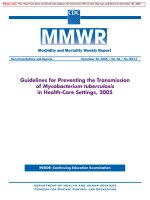Addressing the Threat of Drug-Resistant Tuberculosis potx
Bạn đang xem bản rút gọn của tài liệu. Xem và tải ngay bản đầy đủ của tài liệu tại đây (4.25 MB, 253 trang )
Robert Giffin and Sally Robinson, Rapporteur s
Addressing the Threat
of Drug-Resistant Tuberculosis
W O R K S H O P S U M M A R Y
A Realistic Assessment
of the Challenge
THE NATIONAL ACADEMIES PRESS 500 Fifth Street, N.W. Washington, DC 20001
NOTICE: The project that is the subject of this report was approved by the Govern-
ing Board of the National Research Council, whose members are drawn from the
councils of the National Academy of Sciences, the National Academy of Engineer-
ing, and the Institute of Medicine.
This project was supported by the American Diabetes Association; the Ameri-
can Society for Microbiology; Amgen, Inc.; the Association of American Medical
Colleges; AstraZeneca Pharmaceuticals; Blue Cross Blue Shield Association; the
Burroughs Wellcome Fund; Celtic Therapeutics Management, LLLP; the Critical
Path Institute; the Doris Duke Charitable Foundation; Eli Lilly and Company;
Entelos Inc.; Genentech; GlaxoSmithKline; Johnson & Johnson; the March of
Dimes Foundation; Merck & Co.; the National Institutes of Health—HHS Contract
No. N01-OD-4-2139 (National Cancer Institute, National Center for Research
Resources, National Institute of Allergy and Infectious Diseases, National Institute
of Mental Health, National Institute of Neurological Disorders and Stroke, Office
of Rare Disease Research); Pfizer Inc.; UnitedHealth Group; and the U.S. Food and
Drug Administration—HHS Contract No. 223-01-2460. Any opinions, findings,
conclusions, or recommendations expressed in this publication are those of the
author(s) and do not necessarily reflect the view of the organizations or agencies
that provided support for this project.
International Standard Book Number-13: 978-0-309-13044-8
International Standard Book Number-10: 0-309-13044-1
Additional copies of this report are available from the National Academies Press, 500
Fifth Street, N.W., Lockbox 285, Washington, DC 20055; (800) 624-6242 or (202)
334-3313 (in the Washington metropolitan area); Internet, .
For more information about the Institute of Medicine, visit the IOM home page
at: www.iom.edu.
Copyright 2009 by the National Academy of Sciences. All rights reserved.
Printed in the United States of America
The serpent has been a symbol of long life, healing, and knowledge among almost
all cultures and religions since the beginning of recorded history. The serpent
adopted as a logotype by the Institute of Medicine is a relief carving from ancient
Greece, now held by the Staatliche Museen in Berlin.
Suggested citation: IOM (Institute of Medicine). 2009. Addressing the Threat of
Drug-Resistant Tuberculosis: A Realistic Assessment of the Challenge: Workshop
Summary. Washington, DC: The National Academies Press.
“Knowing is not enough; we must apply.
Willing is not enough; we must do.”
—Goethe
Advising the Nation. Improving Health.
The National Academy of Sciences is a private, nonprofit, self-perpetuating society
of distinguished scholars engaged in scientific and engineering research, dedicated to
the furtherance of science and technology and to their use for the general welfare.
Upon the authority of the charter granted to it by the Congress in 1863, the Acad-
emy has a mandate that requires it to advise the federal government on scientific
and technical matters. Dr. Ralph J. Cicerone is president of the National Academy
of Sciences.
The National Academy of Engineering was established in 1964, under the charter
of the National Academy of Sciences, as a parallel organization of outstanding
engineers. It is autonomous in its administration and in the selection of its members,
sharing with the National Academy of Sciences the responsibility for advising the
federal government. The National Academy of Engineering also sponsors engineer-
ing programs aimed at meeting national needs, encourages education and research,
and recognizes the superior achievements of engineers. Dr. Charles M. Vest is presi-
dent of the National Academy of Engineering.
The Institute of Medicine was established in 1970 by the National Academy of
Sciences to secure the services of eminent members of appropriate professions in
the examination of policy matters pertaining to the health of the public. The Insti-
tute acts under the responsibility given to the National Academy of Sciences by its
congressional charter to be an adviser to the federal government and, upon its own
initiative, to identify issues of medical care, research, and education. Dr. Harvey V.
Fineberg is president of the Institute of Medicine.
The National Research Council was organized by the National Academy of Sci-
ences in 1916 to associate the broad community of science and technology with the
Academy’s purposes of furthering knowledge and advising the federal government.
Functioning in accordance with general policies determined by the Academy, the
Council has become the principal operating agency of both the National Academy
of Sciences and the National Academy of Engineering in providing services to
the government, the public, and the scientific and engineering communities. The
Council is administered jointly by both Academies and the Institute of Medicine.
Dr. Ralph J. Cicerone and Dr. Charles M. Vest are chair and vice chair, respectively,
of the National Research Council.
www.national-academies.org
v
PLANNING COMMITTEE FOR ADDRESSING CHALLENGES IN
DRUG DISCOVERY, DEVELOPMENT, AND DISTRIBUTION FOR
MULTIDRUG-RESISTANT TUBERCULOSIS: A WORKSHOP SERIES
1
Donald M. Berwick, Institute for Healthcare Improvement
Enriqueta C. Bond, Burroughs Wellcome Fund
Gail H. Cassell, Eli Lilly and Company
Anthony S. Fauci, National Institute of Allergy and Infectious Diseases,
National Institutes of Health
Gerald H. Friedland, Yale University School of Medicine
Elaine Gallin, Doris Duke Charitable Foundation
Stephen Groft, Office of Rare Disease Research, National Institutes of
Health
Margaret A. Hamburg, Nuclear Threat Initiative
Jim Yong Kim, Harvard Medical School
Nancy Sung, Burroughs Wellcome Fund
Roy Widdus, Global Forum for Health Research
IOM Staff
Robert B. Giffin, Director
Rebecca A. English, Research Associate
Yeonwoo Lebovitz, Program Associate
Sally Robinson, Program Officer
Andrea Knutsen, Senior Program Assistant
Genea S. Vincent, Senior Program Assistant
Rona Briere, Consulting Editor
1
IOM planning committees are solely responsible for organizing the workshop, identifying
topics, and choosing speakers. The responsibility for the published workshop summary rests
with the workshop rapporteurs and the institution.
vi
FORUM ON DRUG DISCOVERY,
DEVELOPMENT, AND TRANSLATION
1
Gail H. Cassell (Co-Chair), Eli Lilly and Company, Indiana
Jeffrey M. Drazen (Co-Chair), New England Journal of Medicine,
Massachusetts
Barbara Alving, National Center for Research Resources, Maryland
Hal Barron, Genentech, California
Leslie Z. Benet, University of California, San Francisco
Catherine Bonuccelli, AstraZeneca Pharmaceuticals, Delaware
Linda Brady, National Institute of Mental Health, Maryland
Robert M. Califf, Duke University Medical Center, North Carolina
Scott Campbell, American Diabetes Association, Virginia
C. Thomas Caskey, University of Texas-Houston Health Science Center
Peter B. Corr, Celtic Therapeutics, New York
James H. Doroshow, National Cancer Institute, Maryland
Paul R. Eisenberg, Amgen, Inc., California
Gary L. Filerman, Atlas Research, Virginia
Garret A. FitzGerald, University of Pennsylvania School of Medicine
Elaine K. Gallin, The Doris Duke Charitable Foundation, New York
Steven K. Galson, Office of the Surgeon General, U.S. Department of
Health and Human Services, Maryland
Mikhail Gishizky, Entelos, Inc., California
Stephen Groft, National Institutes of Health, Maryland
Edward W. Holmes, National University of Singapore
Peter K. Honig, Merck & Co., Inc., Pennsylvania
A. Jacqueline Hunter, GlaxoSmithKline, United Kingdom
Michael Katz, March of Dimes Foundation, New York
Jack D. Keene, Duke University Medical Center, North Carolina
Ronald L. Krall, GlaxoSmithKline, Pennsylvania
Freda Lewis-Hall, Pfizer, Inc., New York
William D. Matthew, National Institute of Neurological Disorders and
Stroke, Maryland
Musa Mayer, AdvancedBC.org, New York
Mark B. McClellan, Brookings Institution, Washington, DC
Carol Mimura, University of California, Berkeley
John Orloff, Novartis Pharmaceuticals Corporation, New Jersey
Amy P. Patterson, National Institutes of Health, Maryland
Janet Shoemaker, American Society for Microbiology, Washington, DC
1
IOM forums and roundtables do not issue, review, or approve individual documents. The
responsibility for the published workshop summary rests with the workshop rapporteurs and
the institution.
vii
Lana Skirboll, National Institutes of Health, Maryland
Nancy S. Sung, Burroughs Wellcome Fund, North Carolina
Irena Tartakovsky, Association of American Medical Colleges,
Washington, DC
Jorge A. Tavel, National Institute of Allergy and Infectious Diseases,
Maryland
Joanne Waldstreicher, Johnson & Johnson, New Jersey
Janet Woodcock, U.S. Food and Drug Administration, Maryland
Raymond L. Woosley, Critical Path Institute, Arizona
ix
Reviewers
This report has been reviewed in draft form by individuals chosen
for their diverse perspectives and technical expertise, in accordance with
procedures approved by the National Research Council’s Report Review
Committee. The purpose of this independent review is to provide candid
and critical comments that will assist the institution in making its published
report as sound as possible and to ensure that the report meets institutional
standards for objectivity, evidence, and responsiveness to the study charge.
The review comments and draft manuscript remain confidential to protect
the integrity of the process. We wish to thank the following individuals for
their review of this report:
Richard E. Chaisson, Center for Tuberculosis Research, Johns Hopkins
School of Medicine
Ann M. Ginsberg, Clinical Development, Global Alliance for TB Drug
Development
Ruth Levine, Center for Global Development
Fuad Mirzayev, TB/HIV and Drug Resistance, Stop TB Department,
World Health Organization
Lee B. Reichman, Global Tuberculosis Institute, New Jersey Medical
School
Although the reviewers listed above have provided many construc-
tive comments and suggestions, they were not asked to endorse the final
draft of the report before its release. The review of this report was over-
x REVIEWERS
seen by Barry R. Bloom, Harvard School of Public Health. Appointed
by the Institute of Medicine, he was responsible for making certain that
an independent examination of this report was carried out in accordance
with institutional procedures and that all review comments were carefully
considered. Responsibility for the final content of this report rests entirely
with the authors and the institution.
xi
ACRONYMS xv
SUMMARY 1
1 INTRODUCTION 15
Obstacles to Treatment, 16
Workshop Objectives, 17
Organization of This Report, 18
2 THE GLOBAL SPREAD OF MULTIDRUG-RESISTANT
AND EXTENSIVELY DRUG-RESISTANT TUBERCULOSIS 19
Scope of the Problem, 19
Underreporting of MDR TB in Africa, 25
The Threat of Totally Drug-Resistant TB, 33
Importance of Better Data, 33
3 MDR TB TRANSMISSION, HIV COINFECTION,
AND TRANSMISSION CONTROL 35
Coinfection with HIV, 35
Treatment, 36
Transmission of XDR TB, 37
Perspective from Russia, 43
Mitigating Transmission, 43
Implications for Health Care Workers, 49
Contents
xii CONTENTS
4 DIAGNOSIS 51
Actual Need, 51
Diagnostic Quality, 53
Currently Available Diagnostics, 53
Point-of-Care (POC) Diagnostics, 54
5 INFRASTRUCTURE AND HEALTH CARE
DELIVERY SYSTEMS 59
Vertical Versus Horizontal Programs, 59
Approaches to Addressing Infrastructure Problems, 62
Role of Information Technology, 63
6 GLOBAL SYSTEMS FOR THE PURCHASE
AND DELIVERY OF TB DRUGS 67
Procurement Problems, 68
The Drug Quality Issue, 69
Need for Accurate Demand Forecasting, 73
7 RESEARCH ON THE GLOBAL CONTROL OF TB:
UNDERSTANDING THE ROLE OF DRUGS, VACCINES,
AND FUNDING 81
The Pipeline for New Drugs, 82
Probability of Success, 85
Economic Incentives for Drug Development, 93
8 STRATEGIES FOR CONFRONTING THE GLOBAL MDR
AND XDR TB CRISIS 97
Recommendations Presented by Dr. Keshavjee, 97
Lessons Learned from the President’s Emergency Plan
for AIDS Relief (PEPFAR), 102
Policy Focus on Drug-Resistant Versus Non-Drug-Resistant TB, 104
The Level of Response, 105
Summary of Key Points, 107
Closing Remarks, 108
REFERENCES 109
APPENDIXES
A Agenda 113
B Participant Biographies 117
C Partners In Health White Paper—Stemming the Tide of
Multidrug-Resistant Tuberculosis: Major Barriers to
Addressing the Growing Epidemic 139
xiii
TABLES
S-1 Estimated Number of TB Cases and Number of Deaths, by Type,
2006, 3
2-1 Estimated Number of TB Cases and Number of Deaths, by Type,
2006, 21
2-2 Performance of National TB Programs, 27
4-1 Laboratory Capacity in High-Burden Countries, 2006, 52aboratory Capacity in High-Burden Countries, 2006, 52
6-1 Green Light Committee Projects and Patients, 2006–2009, 68
7-1 Four of the Eight TB Vaccine Candidates in Clinical Trials
That Have Moved into Phase II Studies, 91
FIGURES
S-1 MDR TB burden and patients in treatment, 7
2-1 Global incidence of TB, 20
2-2 Per capita incidence of TB, 21
2-3 Two-thirds of the MDR TB burden is located in just three
countries, 22
2-4 Percentage of MDR TB among new TB cases (1994–2007), 26MDR TB among new TB cases (1994–2007), 26
2-5 African countries with a known MDR TB rate, 28
Tables, Figures, and Boxes
xiv TABLES, FIGURES, AND BOXES
2-6 Numbers of MDR TB and XDR TB patients in Tugela Ferry,
2005–2007, 30
2-7 A representation of the limited knowledge of the extent of
MDR TB in KwaZulu-Natal Province, 2006, 31
2-8 High mortality due to MDR and XDR TB in Tugela Ferry
(2005–2007), 32
3-1 MDR TB burden and patients in treatment, 37
3-2 Facilities in KwaZulu-Natal Province where at least one
XDR TB case was described or diagnosed from June 2005
to March 2007, 39
3-3 Genotypes of 17 patients with MDR and XDR TB relapse, 41
3-4 Four TB strains in a single patient, 42
3-5 Partners In Health’s community-based TB treatment triage
strategy in Haiti, 47
6-1 Commodity logistics system in Kenya (as of April 2004), 74
6-2 Artemisinin combination therapy (ACT) supply chain risk map, 77
6-3 Artemisinin combination therapy (ACT) supply chain incentives
map, 78
7-1 Discovery timeline of currently available TB drugs, 83
7-2 Distribution of TB drug targets, 84
7-3 Global clinical portfolio of TB drugs in development, 86
7-4 Federal funding for HIV/AIDS, 1982–2008, 89
7-5 Funding for TB from the National Institute of Allergy and
Infectious Diseases in fiscal year 2007, 90
8-1 A patient being carried by a family member to a clinic, 100
BOXES
3-1 Transmission of MDR and XDR TB in Shanghai, 44
5-1 Universal Access for MDR Care: The Cambodian and
Ethiopian Perspectives, 60
7-1 Examples of Push and Pull Mechanisms for Stimulating Drug
and Vaccine Development, 94
8-1 Specific Recommendations from the Report Stemming the Tide
of Multidrug-Resistant Tuberculosis: Major Barriers to Addressing
the Growing Epidemic, 98
xv
Acronyms
ACH air changes per hour
ACT artemisinin combination therapy
ACTG AIDS Clinical Trial Group
AFRO African regional office
AIDS acquired immune deficiency syndrome
ANRS French National Agency for AIDS Research
ATP adenosine triphosphate
CDC U.S. Centers for Disease Control and Prevention
CGD Center for Global Development
DOTS directly observed treatment, short course
DST drug susceptibility testing
EMEA European Medicines Agency
FDA U.S. Food and Drug Administration
FIND Foundation for Innovative New Diagnostics
GDF Global Drug Facility
GLC Green Light Committee
GLI Global Laboratory Initiative
HIV human immunodeficiency virus
xvi ACRONYMS
IDA International Dispensary Association
IHR International Health Regulations
IOM Institute of Medicine
IT information technology
IUATLD International Union Against Tuberculosis and Lung Disease
LIMS laboratory information management system
MDR TB multidrug-resistant tuberculosis
MEND Medicine in Need
MIRU mycobacterial interspersed repetitive unit
MRSA methicillin-resistant Staphylococcus aureus
MSH Management Sciences for Health
NGO nongovernmental organization
NIAID National Institute of Allergy and Infectious Diseases
NIH National Institutes of Health
PCR polymerase chain reaction
PEPFAR U.S. President’s Emergency Plan for AIDS Relief
PETT CDC’s Preserving Effectiveness of TB Treatment study
PHLIP Public Health Laboratory Interoperability Project
POC point of care
PRV priority review voucher
R&D research and development
RFLP restriction fragment length polymorphism
SA Staphylococcus aureus
SRL Global Supranational Reference Laboratory
TB tuberculosis
UNICEF United Nations Children’s Fund
USAID U.S. Agency for International Development
UV ultraviolet
WHO World Health Organization
XDR TB extensively drug-resistant tuberculosis
Tuberculosis (TB) kills more than 4,500 people each day worldwide;
approximately 1.7 million TB deaths occurred in 2006 alone (WHO,
2008a). TB is second only to AIDS as the leading infectious disease–related
cause of adult deaths. Although antibiotic treatment for TB was discovered
more than half a century ago, an estimated one-third of the world’s popula-
tion is currently infected with Mycobacterium tuberculosis (Keshavjee and
Seung, 2008), and 9.2 million new cases of active TB are estimated to occur
around the world annually (WHO, 2008a).
A large percentage of TB cases can be treated effectively with available
antibiotics. But multidrug-resistant TB (MDR TB)—strains of TB that are
resistant to the two principal first-line TB drugs—is a major and growing
global problem. While MDR TB has been under control in the United States
since it was first recognized, worldwide an estimated 4.8 percent of all new
and previously treated TB cases diagnosed in 2006—nearly half a million
cases—were MDR according to the World Health Organization (WHO,
2008b). These cases are considered by many to be a substantial underesti-
mate. Moreover, some strains of TB—termed extensively drug-resistant TB
(XDR TB)—are resistant even to second-line therapies, and strains of TB
that are totally resistant to all drugs are now emerging.
The combination of HIV and TB has proven to be especially deadly.
At least one-third of the 33 million people living with HIV worldwide are
coinfected with TB (WHO, 2008c). As a result of their weakened immune
system, HIV-positive patients often develop active TB. In 2000, TB was
identified as the cause of 11 percent of all AIDS-related deaths (Corbett et
al., 2003).
Summary
1
2 THREAT OF DRUG-RESISTANT TUBERCULOSIS
The global health apparatus has been slow to respond to the transfor-
mation of TB into highly drug-resistant forms. Outmoded techniques for
diagnosis and treatment are still common throughout the world, and only
a small fraction of MDR TB worldwide is currently diagnosed and treated.
The characterization and epidemiology of MDR TB have been slow to
emerge. Only 11 of the 22 highest-burden TB countries provide data on
drug-resistant TB, and even fewer have the capability to assess patients’
susceptibility to the second-line drugs used to treat MDR TB. Severe prob-
lems exist in the supply of drugs, and adequate health systems for delivering
treatment to patients are lacking. When treatment is delivered, moreover, it
is often inappropriate or incomplete. The failures of the system are them-
selves adding to the problem—when treatment is inadequate or interrupted,
drug resistance accelerates.
WORKSHOP OBJECTIVES
To examine these issues and explore strategies for enhancing the global
response to MDR TB, the Institute of Medicine’s (IOM’s) Forum on Drug Dis-
covery, Development, and Translation held a workshop in Washington, DC,
on November 5, 2008. The goals of this workshop were to understand the
magnitude and nature of the drug resistance problem; to assess the adequacy
of the current global response; and to examine key obstacles to effective diag-
nosis and treatment, including inadequate diagnostic capacity, a lack of new
drugs, bottlenecks in the supply chain of existing drugs, drugs that are coun-
terfeit or of poor quality, suboptimal treatment regimens and patient manage-
ment practices, inadequate infection control, inadequate in-country health
systems, and a lack of resources. The workshop brought together a wide
range of experts and organizations engaged in the global effort to combat TB
to share information, develop an understanding of the challenges, and con-
sider opportunities and strategies for confronting the problem. Speakers from
around the world presented data and described firsthand their experiences
with MDR and XDR TB in multiple countries, including China, Cambodia,
Ethiopia, Russia, and South Africa. In addition, to provide baseline informa-
tion on MDR TB and outline the issues for discussion during the workshop,
the IOM commissioned a white paper from Partners In Health.
The workshop presentations and discussions focused attention on seven
key issues:
1. Limitations of global TB estimates,
2. The role of HIV in the spread of MDR TB,
3. The importance of infection/transmission control,
4. Limited diagnostic capacity,
5. Low rates of treatment,
SUMMARY 3
6. Bottlenecks in the procurement and distribution of high-quality
drugs, and
7. The need for new TB drugs.
ISSUES
Limitations of Global TB Estimates
WHO has estimated that of the more than 9 million cases of TB in
2006, approximately half a million (or 4.8 percent) were MDR TB, and
about 40,000 (or 0.4 percent) were XDR TB (Nunn, 2008) (see Table S-1).
Many consider these to be underestimates of the actual incidence of drug-
resistant TB, however, for several reasons. First, drug resistance surveys
have not been conducted in 25 of the 46 countries in Africa. Second, in
many countries, the availability of diagnostic laboratories is limited; for
example, 9 African countries lack even a single reference laboratory capable
of culturing TB and making a diagnosis. Further, current drug resistance
surveys include only smear-positive TB cases, yet not all MDR TB cases are
smear positive. In particular, in many countries with a high TB burden, the
incidence of HIV infection is also very high, and HIV-positive TB patients
are more likely than other TB patients to be smear negative. It was pointed
out during the workshop that underreporting of rates of infection may
have serious consequences, since it may weaken the political will to take
appropriate measures to combat the MDR TB threat.
Role of HIV in the Spread of MDR TB
As noted, individuals who are HIV positive have compromised immune
systems and are thus more susceptible than the general population to TB
TABLE S-1 Estimated Number of TB Cases and Number of Deaths, by
Type, 2006
Form of TB
Estimated Number
of Cases
Estimated Number
of Deaths
All forms 9,200,000 1,650,000
Multidrug-resistant (MDR TB)
489,000 120,000
Extensively drug-resistant (XDR TB) 40,000 20,000
HIV-associated 700,000 200,000
SOURCE: Nunn, 2008. (The data on total cases and deaths are from WHO, 2008a; the number
of MDR TB cases is from WHO, 2008b; the deaths from MDR and XDR TB were estimated by
Nunn’s team from published literature using the case numbers listed in the table; and the number
of XDR TB cases [according to the revised October 2006 definition of XDR TB] was estimated
from the MDR TB number listed in the table using the percentages from CDC, 2006.)
4 THREAT OF DRUG-RESISTANT TUBERCULOSIS
infection. Coinfection with HIV and MDR TB has received particular atten-
tion in Africa, although it is also a growing problem in Eastern Europe.
The progression of the TB epidemic in KwaZulu-Natal, South Africa, for
example, has been closely intertwined with that of HIV. A large percent-
age of the province’s residents now have compromised immune systems
that make them increasingly vulnerable to infection and the progression
of disease.
The coincidence of TB and HIV has both accelerated TB drug resis-
tance and contributed to the rapid transmission of HIV. Limited infection
control facilities and practices compound the problem. Health care facilities
routinely house patients who are HIV positive with those who have drug-
resistant TB, creating opportunities for nosocomial transmission. Recent
efforts have been aimed at deinstitutionalizing and decentralizing care by
focusing on community-based treatment in people’s homes, thereby reduc-
ing such opportunities.
Importance of Infection/Transmission Control
There are two pathways for infection with drug-resistant TB. Acquired,
or amplified, resistance typically emerges in settings where TB treatment is
inadequate, patients fail to adhere to proper treatment regimens, or incor-
rect or non-quality-assured drugs are used for treatment. Transmitted, or
primary, resistance results from the direct transmission of drug-resistant
strains from one person to another. Neel Gandhi of the Tugela Ferry Care
and Research Collaboration stated that this latter mechanism has largely
been neglected during the development of TB control programs.
Drug-resistant strains of other diseases typically are not as resilient
as drug-susceptible strains and therefore tend to die out. While acquired
or amplified resistance due to inadequate treatment may explain how the
cases of MDR and XDR TB first emerged in South Africa and other parts
of the world, however, speakers presented substantial evidence of transmit-
ted rather than acquired TB. In one study, for example, about half of those
patients who died from highly resistant forms of TB had never before been
treated for the disease, and 85 percent had a genetically similar strain,
indicating that resistance was likely transmitted rather than acquired.
Other studies using molecular fingerprinting have shown that patients who
relapsed with MDR or XDR TB had different genotypes in their relapse
isolate compared with their initial isolates, suggesting that their relapses
occurred as a result of primary transmission rather than acquired resistance.
Gandhi suggested several lessons from these studies:
• Efforts must focus on creating infection control programs to prevent
the further transmission of drug-resistant strains.
SUMMARY 5
• Early diagnosis of MDR and XDR TB cases, which is currently
hampered by a lack of laboratory capacity and rapid diagnostic
tests (see below), will be critical to infection control.
• Further studies are needed to better characterize transmission
patterns both in hospitals and in communities so that other means
of curbing the epidemic can be devised.
Implementing effective transmission control in resource-limited settings,
however, presents major challenges. For example, establishing community-
based treatment outside a hospital is not currently feasible in some settings
because the tradition and infrastructure for community care do not exist.
Transmission control can be very expensive, particularly when elaborate
ventilation systems are required, and the necessary technical expertise is
often lacking. Furthermore, the importance of undiagnosed and unsuspected
cases in the spread of disease is often underappreciated. Edward Nardell of
Brigham and Women’s Hospital described a number of potential strategies
for reducing the transmission of drug-resistant TB, including hospital triage
and separation; ventilation; and research on novel interventions, such as the
use of germicidal ultraviolet (UV) air disinfection and the development of
inhaled antibiotics.
Limited Diagnostic Capacity
WHO recommends that countries maintain at least one culture labora-
tory per 5 million people and one facility capable of conducting drug sus-
ceptibility testing per 10 million. Only a handful of high-burden countries
meet these standards, and many countries lack even a national reference
laboratory to perform some of the most basic surveillance. Furthermore,
many experts consider the recommended numbers to be wholly inadequate.
It is estimated that a mere 5 percent of all MDR TB cases are currently
being detected.
While current global capacity allows for the conduct of approximately
10 million culture tests, WHO has estimated that the actual need is at
least 60 million (Weyer et al., 2007). According to John Ridderhof of the
U.S. Centers for Disease Control and Prevention (CDC), to meet current
needs, hundreds or even thousands of new laboratories would have to be
developed worldwide, representing an investment in laboratory capacity of
$1 billion or more. WHO and the Stop TB Partnership created the Global
Laboratory Initiative (GLI) in 2007 to begin to address this gap, but the
GLI’s modest goal is to diagnose 74,000 new MDR TB patients by 2011.
Cost-effective point-of-care TB testing is also critically important. Ideally,
such tests would be performed during a patient’s visit so that appropriate
treatment could begin immediately. There have been recent breakthroughs
6 THREAT OF DRUG-RESISTANT TUBERCULOSIS
in the development of point-of-care systems, and two portable systems were
presented and discussed at the workshop. But such technology is likely to
remain unattainable for those in resource-poor settings.
An example of the type of test envisioned by many is the dipstick test
used in HIV diagnostics. That test, which costs US$1.00 and is 99 percent
sensitive and specific, revolutionized HIV testing and was a key element in
the scale-up of antiretrovirals worldwide. As Mark Harrington of the Treat-
ment Action Group noted, “In some ways [point-of-care testing] is even
more important than a new drug or a new vaccine. There is a cure for most
cases of TB, and there is reasonable treatment for MDR. But if it can’t be
diagnosed, millions of people will die of a treatable and curable disease.”
To achieve the goal of a rapid, inexpensive, and effective point-of-care
diagnostic test, support will be needed from large organizations such as the
National Institutes of Health and the Bill and Melinda Gates Foundation,
along with small-scale innovative efforts supported by smaller donors.
Low Rates of Treatment
Only a small proportion of newly diagnosed cases of MDR TB are
being treated either through Green Light Committee (GLC)–approved or
non-GLC-approved treatment programs (see Figure S-1). Even among the
small proportion of patients who are being treated, many are not receiving
drugs that are quality assured through the GLC program. For others, treat-
ment may not address their drug resistance profile, making their treatment
ineffective.
Furthermore, the public health infrastructure needed to deliver TB care
cost-effectively is inadequate in many resource-poor environments. Current
programs are often fragmented and limited in scale, and it is frequently
difficult to scale up successful programs to the regional or country level.
Effective public health models, such as providing patients with housing as
an alternative to hospitalization and training villagers to serve as commu-
nity health workers, have yet to be widely adopted. Technical assistance,
when available, often lacks coordination.
It was noted that experience with the U.S. President’s Emergency Plan
for AIDS Relief (PEPFAR) could be instructive for the fight against TB.
Substantial funding for HIV/TB programs was an important factor in the
success of PEPFAR—funding increased from $18.8 million in 2005 to $169
million in 2008, more than 700 percent. In addition, PEPFAR established a
supply chain management system for both forecasting demand and deliver-
ing drugs, fast-tracked U.S. Food and Drug Administration (FDA) approval
of new and generic antiretroviral drugs, fostered community-based delivery
of care, invested in improved laboratory surveillance systems, built a tiered
SUMMARY 7
public health laboratory network and transport system for samples, and set
specific performance targets.
Bottlenecks in the Procurement and Distribution of High-Quality Drugs
Continuing problems constrain the procurement and distribution of
high-quality TB drugs worldwide. Treatment and drug quality vary tremen-
dously across programs and countries. The markets for second-line drugs in
priority countries are large and growing rapidly, but they are fragmented,
and regulation is inconsistent. The absence of accurate demand forecasting
creates financial risks for both suppliers and programs and disrupts the
flow of drug supplies.
Ruth Levine of the Center for Global Development discussed the criti-
cal role of accurate demand forecasting, drawing on lessons learned from
FIGURE S-1 MDR TB burden and patients in treatment.
NOTES: The bars represent the number of new MDR TB cases in each year. Data
for 2007 and 2008 are WHO estimates. The lavender portions indicate the number
of patients treated in non-GLC-approved projects; the purple portions indicate the
number of patients treated in GLC-approved projects; and the yellow portions rep-
resent patients receiving no treatment. GLC = Green Light Committee.
SOURCE: Zintl, 2008 (based on unpublished data from GLC Secretariat, Geneva
2008).
2
10
12
16
16
21
36 34
407 407
427
403
443
0
100
200
300
400
500
2004 2005 2006
Year
Number of Patients (in thousands)
2007 2008
Estimated new,
untreated cases
Non-GLC cases
GLC cases
21
Estimated
489,000 new
MDR TB cases
each year
Figure 3-1
8 THREAT OF DRUG-RESISTANT TUBERCULOSIS
dealing with malaria. WHO’s malaria drug demand forecasts have been
off by orders of magnitude. For example, the original demand for Coartem
was estimated to be 55 million doses; the actual orders turned out to total
14 million. The following year, WHO estimated that 100 million doses
would be demanded and purchased; the actual number turned out to be
55 million. Likewise, the manufacturer had to discard 10 million tablets of
artesunate because of overforecasts. There are also serious problems with
the quality of TB drugs, and countries are not sufficiently insistent that
their MDR TB patients be treated with second-line drugs that are of high
quality—meaning in most cases that they are potent enough. Anecdotal
reports of quality issues are widespread, but actual data on the quality of
many drugs being used are limited. Paul Nunn of WHO described current
WHO efforts to collect data on drug quality by looking randomly at TB
drugs from various sites in different countries and measuring their active
ingredients—similar to what was done with AIDS and malaria. But results
from those studies are months away.
To ensure the quality of second-line drugs being supplied to high-
burden countries and to improve the reliability of supply, the GLC was
formed in 2000. Substantial growth has occurred in the number of GLC-
approved projects and the numbers of patients treated. In 2006, just over
5,500 patients were enrolled in 32 approved projects; by 2007, 30,000
patients were enrolled in 104 projects. The latter figure includes a rapid
ramp-up in the African region from 0 to 15 projects, as well as a large
number of projects in Eastern Europe.
Despite this recent growth, GLC projects represent only a tiny fraction
of the more than 400,000 MDR TB cases estimated to occur each year.
The vast majority of patients are being treated through non-GLC-approved
projects under programmatic conditions that may not be ideal for treat-
ment of MDR TB and with drugs that are not quality assured. But the
requirements for GLC participation can be onerous and costly, and as a
result, many countries and suppliers prefer to circumvent the GLC process.
With one exception, only one quality-assured supplier exists for each of the
second-line drugs for GLC projects.
Workshop participants offered a number of suggestions for improving the
procurement and distribution of TB drugs. These included improving forecast-
ing, aligning the incentives for key stakeholders along the supply chain, and
ensuring that the GLC procurement process is clear and straightforward.
Need for New TB Drugs
The global fight against TB has been impeded by the lack of new drugs
and vaccines. The current classes of both first- and second-line TB drugs
were all discovered between the 1940s and the 1960s. The last approval for

